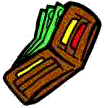Are you attempting to raise money for a local charity? Were you asked to organize the rummage sale, auction, charity walk or other special event?
Typically, organizations attempt to sell services or products to those who use or need their services as a way to raise funds. That’s a tried and true approach, but even better way is to increase your fundraising power by finding the hidden donors.

Who is a hidden donor? A hidden donor is any person, organization, club, group or business whose goals align with those of your organization.
How do you find the hidden donor?
Step One
The first step in finding the hidden donor is to be clear about why you are raising money. Let’s say you are attempting to raise $8,000 to put new books into the town library for young readers. You might think your goal is to buy books but your real goal is to enhance the education of young people so they in turn become better citizens, contributing members of society and capable employees. When you begin to examine the goal instead of the need, you will be able to see who the hidden donors for your project might be. In the example of the library book drive, you might find hidden donors are institutes of higher learning, employers in the vicinity or local professional associations.
Step Two
The second step in finding the hidden donor is to think beyond those who use your service to those who get a side benefit from your service. If you offer a program of recreation or aid to seniors, then their adult children are probably very appreciative of what your program does and would most likely be very receptive to giving to your organization. For this reason, it’s important to keep not only the names and addresses of those who use your services but also those who are primary contacts of these individuals.
Step Three
A third step to gold mining for hidden donors is to start a mailing list and newsletter. Even if someone does make a donation, it’s important to keep that person informed of your group’s activities and programs. “Non-givers” are sometimes the same people who make a substantial donation through a will or insurance proceeds. Don’t overlook a small donor or a non-giver. If these people don’t want to receive your mailings, they’ll let you know otherwise consider them to be invested and interested in your program.
In-kind gifts of services, products or assistance can be as valuable or more valuable than actual cash. Many hidden donors like to donate in this way. A local restaurant might be willing to donate sandwiches for hard-working volunteers. A musician might offer his or her services for your next special event. Print shops can offer to make brochures or fliers. There’s no end to what you can do to reduce your budget and offset expenses through in-kind gifts. Just be sure to give your in-kind donors the same kind of acknowledgement as is given to any other donor.
Like most donors, “hidden donors” may not be giving to your charity or service program because no one has ever asked them to do so. Once you start digging and discover who your hidden donors might be, be sure to knock on their doors and request their help. If you are clear about how your goals align with their goals or needs, you will likely be surprised to learn how many of these hidden donors are ready to give, and give generously.
I need donors I am writing a project on orphans who are affected by the ebola in sierra leone.
Need money for Gospel work.
I need donor money. Small children suffer from air pollution and toxic substances.